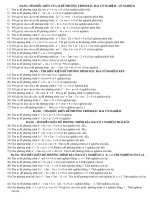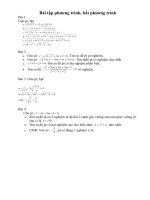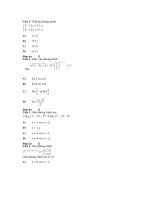Bài giảng Real-time Systems Week 3: Task and Task Synchronization
Bạn đang xem bản rút gọn của tài liệu. Xem và tải ngay bản đầy đủ của tài liệu tại đây (609.84 KB, 31 trang )
Real-time Systems
Week 3:
Task and Task Synchronization
Ngo Lam Trung
Dept. of Computer Engineering
NLT, SoICT, 2015
Content
Task
Task synchronization
Semaphore and mutex
Philosopher’s problem
Deadlock
NLT, SoICT, 2015
Defining a task
Independent thread of execution that can compete with
concurrent tasks for processor execution time.
Thus, schedulable & allocated a priority level according to the
scheduling algorithm
Elements of a task
Unique ID
Task control block (TCB)
Stack
Priority (if part of a preemptive scheduling plan)
Task routine
NLT, SoICT, 2015
Elements of a task
NLT, SoICT, 2015
Task states & scheduling
Task states:
Ready state
Running state
Blocked state
Scheduler
determines each
task’s state.
running
blocked
dispatched
preempted
unblocked
ready
unblocked
blocked
NLT, SoICT, 2015
Task states
ready state-the task is ready to run but cannot because
a higher priority task is executing.
blocked state-the task has requested a resource that is
not available, has requested to wait until some event
occurs, or has delayed itself for some duration.
running state-the task is the highest priority task and is
running.
NLT, SoICT, 2015
Typical task structure(1)
Typical
task structures:
Run-to-completion task: Useful for initialization & startup
tasks
NLT, SoICT, 2015
Typical task structure(2)
Typical
task structures:
Endless-loop task: Work in an application by handling inputs
& outputs
NLT, SoICT, 2015
Semaphores
In multi-task systems, concurrently-running tasks should
be able to
synchronize their execution, and
to coordinate mutual exclusive access to shared resources.
What is semaphore?
A kernel object to realize synchronization & mutual exclusion
One or more threads of execution can acquire & release to
execute an operation to be synchronized or to access to a
shared resource.
NLT, SoICT, 2015
Semaphore elements
NLT, SoICT, 2015
Defining semaphore
Elements of semaphores assigned by the kernel
Semaphore control block (SCB)
Semaphore ID (unique in the system)
Value (binary or count)
Task-waiting list
Classification of semaphores:
Binary semaphore
Counting semaphore
Mutex
NLT, SoICT, 2015
Binary semaphore
Provides binary state of unavailable/available (or empty/full)
Task 1
Task 2
Can’t acquire semaphore
during Task 1’s
acquirement
Acquire semaphore
(P operation)
Acquire
Releasesemaphore
semaphore(P
operation)
(V operation)
Release semaphore
(V operation)
Semaphore
Task 3
value
value
Initial
value1:
value1:
1:
0:available
unavailable
available
available
Any tasks can release semaphore
if it is global resource
NLT, SoICT, 2015
Counting semaphore
If the value of a semaphore is n, it can be acquired n
times concurrently.
NLT, SoICT, 2015
Mutual exclusion (MUTEX) semaphores
Special binary semaphore
Has states of locked/unlocked & lock count
Difference: signaling vs protecting
NLT, SoICT, 2015
Mutual exclusion (MUTEX) semaphores
Special features of MUTEX
Ownership: When a task acquires the mutex, no other task can
release it.
- General semaphores: released by any task
Recursive locking: allows the owner task to re-acquire the mutex
multiple times in the locked state
- The number of times of recursive acquirement is managed
by lock count.
- Useful when the owner task requires exclusive access to
shared resource and calls routines that also require the
same resource
- Problem: recursion and deadlock
NLT, SoICT, 2015
Mutual exclusion (MUTEX) semaphores
Special features of MUTEX
Task deletion safety: avoiding a task deletion while it is locking a
mutex
Priority inversion avoidance:
- Priority inversion problem: a higher priority task is blocked and is
waiting for a resource being used by a lower priority task, which has
itself been preempted by an unrelated medium-priority task
- To avoid priority inversion additional protocols are required, eg
priority inheritance protocol, or priority ceiling protocol
NLT, SoICT, 2015
Semaphore vs Mutex
All processes can release semaphore
Only owner is able to unlock mutex
NLT, SoICT, 2015
Typical semaphore use
Semaphore are used for:
Synchronizing execution of tasks
Coordinating access to a shared resource
Synchronization design requirements
Wait-and-signal
Multiple-task wait-and-signal
Credit-tracking
Single shared-resource-access
Recursive shared-resource-access
Multiple shared-resource access
NLT, SoICT, 2015
Typical semaphore uses
NLT, SoICT, 2015
Example:
Consumer – producer problem
Producer:
Task to read data from input device,
Data transferred to 4KB shared buffer memory
Consumer:
Task to read and process data from buffer memory
Synchronization problem
Solution 1: binary semaphore for buffer memory access
Other solution?
NLT, SoICT, 2015
Example: The Dining Philosophers Problem
Five philosophers seated around a
circular table with a plate of
spaghetti for each.
Between each pair of plates is one
fork
The spaghetti is so slippery that a
philosopher needs two forks to eat
it.
When a philosopher gets hungry,
he tries to acquire his left and right
fork
Problem: not enough forks for all
Write a program to control philosophers concurrently without getting stuck?
NLT, SoICT, 2015
Solution 1:
#define N 5/* number of philosophers */
void philosopher(int i)/* i: philosopher number, from 0 to 4 */
{
while (TRUE) {
think( ); /* philosopher is thinking */
take_fork(i); /* take left fork */
take_fork((i+1) % N);/* take right fork; */
eat(); /* yum-yum, spaghetti */
put_fork(i); /* Put left fork back on the table */
put_fork((i+1) % N);/* put right fork back table */
}
}
This is non-solution, because of potential deadlock. Why?
NLT, SoICT, 2015
Solution 2:
If philosopher could not acquire fork:
Wait for a random duration
Retry
Simple and efficient
Minimize lock-state time
But not lock-state free
Cannot be used in critical system
NLT, SoICT, 2015
Solution 3
#define N 5 /* Number of philosphers */
#define RIGHT(i) (((i)+1) %N)
#define LEFT(i) (((i)==N) ? 0 : (i)+1)
typedef enum { THINKING, HUNGRY, EATING } phil_state;
phil_state state[N];
semaphore mutex =1;
semaphore s[N]; /* one per philosopher, all 0 */
void test(int i) {
if ( state[i] == HUNGRY && state[LEFT(i)]!= EATING &&
state[RIGHT(i)] != EATING )
{
state[i] = EATING;
up(s[i])
}
}
NLT, SoICT, 2015
Solution 3
void get_forks(int i){
down(mutex);
state[i] = HUNGRY;
test(i);
up(mutex);
down(s[i]); //lock
}
void philosopher(int process)
{
while(1)
{
think();
get_forks(process);
eat();
put_forks(process);
}
}
void put_forks(int i){
down(mutex);
state[i]= THINKING;
test(LEFT(i));
test(RIGHT(i));
up(mutex);
}
NLT, SoICT, 2015









